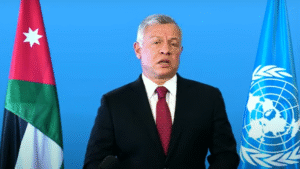The moderate Arab coalition in the Middle East, spearheaded by Saudi Arabia, has seen a decline in influence due to perceived leniency in the Biden administration’s approach toward Iran.
Jordan has witnessed its largest demonstrations in recent memory, with protesters expressing support for Hamas and opposing the continuation of conflict in the Gaza Strip.
These protests, orchestrated by Hamas and the Muslim Brotherhood in coordination with Iran, aim to undermine the rule of King Abdullah and create a new front against Israel along the Jordanian border.
King Abdullah, a longstanding ally of the US, faces mounting pressure to quell the unrest. Speculation is rife that if the protests persist and pose a threat to the stability of the Hashemite monarchy, the king may resort to forceful measures to suppress dissent, akin to his father’s actions during the events of September 1970, infamously known as “Black September.”
The demonstrations underscore the vulnerability of the Hashemite monarchy amidst the growing influence of the Iran-led resistance axis.
This axis, including Hamas, seeks to undermine Jordan’s peace agreement with Israel and disrupt the gas deal, potentially transforming the Jordan-Israel border into a new battleground.
The situation in Jordan highlights the perceived weakness of President Biden’s Middle East policy, characterized by what critics view as a lack of resolve in dealing with Iran.
A more assertive stance towards Iran could have deterred challenges to King Abdullah’s rule.
Public anger in Jordan is fueled by economic hardship and government corruption, providing fertile ground for Hamas to exploit discontent and destabilize the government.
Senior Hamas leaders have openly encouraged mass protests and even urged demonstrators to breach the Israeli border in pursuit of Jerusalem’s liberation and the Al-Aqsa Mosque’s freedom from Israeli occupation.
Hamas perceives the unrest in Jordan as a consequence of the “Al-Aqsa flood” attack on October 7.
Jordan serves as a crucial gateway to the Arab world and is seen as a bridge to the West Bank, Iraq, Saudi Arabia, the Gulf states, and Yemen.
Iran and its resistance axis pose a threat to the stability of Arab regimes, reminiscent of the “Arab Spring” uprisings in 2011.
The specter of a “domino effect” looms large, potentially spreading from Jordan to other US-aligned Arab nations.
In response, it is expected that Gulf countries will extend financial assistance to Jordan to bolster its stability against the Hamas and Muslim Brotherhood threat, as well as the broader influence of Iran.
Their aim will be to contain the threat and prevent its spread to their own territories.




